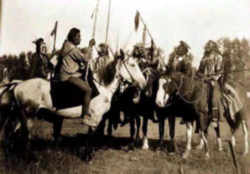


Vermont Symbols
Vermont Early History
First Early Inhabitants of Vermont

Early history examines the archaeological record that tells the story of the first inhabitants of Vermont. Learn about the prehistory and culture of the first early inhabitants, and what lessons it might teach us about the early history of Vermont.
Vermont First Early Inhabitants Timeline
- 1.3 billion years ago - the Adirondack mountain range was formed.
- 450 million years ago - the Iapetus Ocean was a shallow tropical sea.
- 440-350 million years ago the Green mountains were formed when the North American and European continents collided. Between the Adirondacks and the Green Mountains the Champlain Valley was formed.
- 5 million years ago - huge glacial ice sheets carved the soft sedimentary rock in the Champlain valley. Some of these ice sheets were more than one mile thick.
- 21,000 years ago - Glaciers started melting northward toward New England
- 14,000-15,000 years ago - Lake Vermont was formed as the glaciers melted and then blocked the outflow of water.
- 13,000 years ago - the Champlain Sea replaced Lake Vermont when ocean water from the north flooded the basin.
- 11,000 years ago - Lake Champlain was formed. The earth's crust rebounded from the weight of the glacier and the Champlain Valley was cut off from the sea. Over time the seawater was replaced by fresh water from local rivers and streams.
- 8500 - 7000 BC - Glacial activity creates Champlain Sea; Paleo-Indians explore and hunt in Vermont
- 7000 - 1000 BC - Archaic Period; Native Americans move seasonally around Vermont to live, hunt, gather, and fish
- 1000 BC - 1600 AD - Woodland Period; Native Americans establish villages and develop trade networks, and ceramic and bow and arrow technology
- 1535 - Jacques Cartier (1491-1557) is first European to sight Vermont
- 1688 - 1763 - The French and Indian Wars between France and Great Britain for lands in North America consisting of King William's War (1688-1699), Queen Anne's War (1702-1713), King George's War (1744 - 1748) and the French and Indian War aka the Seven Years War (1754-1763)
- 1688 - 1699 - King William's War (part of the French and Indian Wars) between France and the Wabanaki Confederacy and England and the Iroquois Confederacy. Peace Treaty made at Pemaquid. August 11,1693. and was ratified on Jan. 7. 1699
- 1702 - 1713 - Queen Anne's War (part of the French and Indian Wars) between the French and Spanish colonies allied with the Wabanaki Confederacy, Mohawk, Choctaw, Timucua, Apalachee and Natchez tribes against the British colonies allied with the Muscogee (Creek), Chickasaw and Yamasee tribes.
- 1744 -1748 - King George's War (part of the French and Indian Wars) between the French colonies allied with the Wabanaki Confederacy and the British colonies allied with Iroquois Confederacy
- 1754 - 1763 - The French Indian War is won by Great Britain against the French so ending the series of conflicts known as the French and Indian Wars
- 1763 - Treaty of Paris
- 1780 - Last major Indian raid, led by the British, in Royalton
Early History of Native Americans in Vermont
The Indigenous People of Vermont
The names of the Vermont tribes included the Abenaki, Mohican, Pennacook and the Pocomtuc tribes.
Vermont's story begins with the native peoples who frequented the territory between the Connecticut River and Lake Champlain long before the Europeans
came. Between 7,000 and 5,500 BC, we know that small groups of people lived throughout the lowlands of the Champlain Valley and along the Walloomsac
River in southwestern Vermont. By around 4000 BC, the climate began to warm, and the number of people living in the area grew. The Natives were nomadic
in most cases, however, and there were a few permanent settlements. Those without permanent villages returned to the same places year after year to
raise corn or other crops. Evidence of woodworking tools seems to indicate that the people used dugout canoes for transportation along Vermont's rivers.
By the materials used to make tools and other items, we know that the people traded with others. The Early Woodland period, beginning around 900 BC,
brings the first evidence of pottery and bow and arrow.
The earliest known Native farm site in Vermont is in Springfield, on the Connecticut River, and dates from around 1100 AD - nearly 400 years before
Columbus. The Native American inhabitants of this area were the Abenaki, a tribe of the Algonquin nation. Archaeologists have discovered evidence of
Abenaki villages along the shores of Lake Champlain near the mouth of the Winooski River. "Winooski" is an Abenaki term for "wild onion." Abenaki villages
were also located along the Connecticut River.
The arrival of Samuel de Champlain in 1609 signaled the beginning of the end of the native culture of Vermont. Although the native people had survived
changes in climate, the availability of food and other hardships for nearly 11,000 years, the Natives could not compete with the arrival of Europeans
and their diseases and desire for land. Between 1600 and 1800, Vermont's native population was almost completely wiped out.





